Heating
The central heating systems in the UK are predominantly hot water radiator based, which is unlikely to change significantly in the near to medium term. Improvements have been made over the years, but are limited by the need to retrofit them to existing central heating systems.
Electronic devices for scheduling, etc., have been added over the years, with smart heating systems being the most recent.
The ultimate goal, for both comfort and efficiency, is to have zone heating, and especially at room level. The use of smart TRVs, which is still an embryonic technology, is the only viable option in the medium term.
Early Central Heating Systems
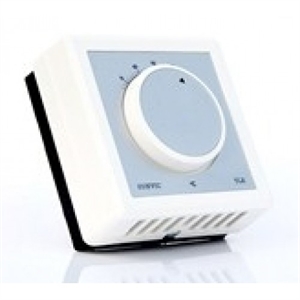
By 1970, less than one third of UK households had central heating. One half of all new installations occurred during the next 20 years, and there are now some 26 million households with some form of central heating.
These systems employed a fairly basic mechanical thermostat, which was often located in the hallway.
Some households will have upgraded to a more modern thermostat, many of which are direct replacements for their older existing units. Some of these devices also include a timer to control the heating schedule. Others are simple thermostats. These rely on a separate, and often existing, timer, which is traditionally located more adjacent to the boiler.
Wireless Thermostats
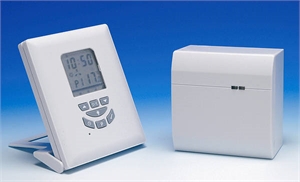
Wireless thermostats, such as the Sunvic TLX RFP, were first introduced at least 15 years ago.
These had two main advantages over the older thermostats.
The thermostat, being battery powered and portable, could be located in a more suitable location, such as the living room.
The receiving unit, which controls the heating, was a direct replacement for the existing thermostat, so no wiring modifications were required.
Reflective LCD Displays
In common with most thermostats, this thermostat was fitted with reflective liquid crystal displays to minimize the power consumption, and hence maximize the battery life.
The visibility of the display relies on the light falling on it, which is either absorbed or reflected. There is invariably some form of local lighting when the display is being viewed.
As shown in the above photograph, the characters are set to be non-reflective, so the light is absorbed, and they appear black. The rest of the display reflects the light, so it appears white, or some other background colour.
Very little power is consumed by a liquid crystal display to hold the crystals in these states. The main power consumption occurs when the characters are being changed.
This particular type of unit runs on two AA batteries, which are known to last many months, if not years.
Smart Heating Systems
Several suppliers have entered this market in recent years with smart heating systems. Their main advantage is that they enable users to control their heating when away from home. To do so, they require a separate controller / hub, a connection to the Internet, and a mobile phone app, through which the user is able to control the system remotely.
Whether the cost of the hub, the app, an Internet connection, and a cloud service subscription service can be justified in relation to the convenience of remote access is open to question.
If these costs can be spread over other smart applications within the home, then they become more justifiable. Even so, the benefit of remote access has been negated to some degree by Internet drop-outs, difficulties in setting up the system, unreliability with the system, firmware issues, and failures in the associated cloud services.
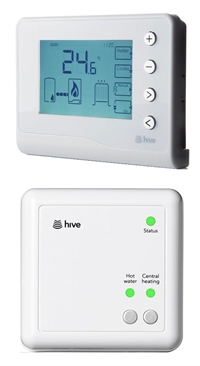
Most of our central heating testing with the new system has been conducted with British Gas Hive thermostats and heating receivers.
Both the Version 1 and the Version 2 thermostat have been tested, together the Hive heating and heating / hot water receivers. The Version1 thermostat, as shown in the photograph, is preferred over the more recent version, because it is easier to viewing, and has a much longer battery life.
We have been running a central heating system with a pre-owned Version 1 thermostat and pre-owned heating receivers for over a year. During this time, the two AA batteries in the thermostat have been changed only once.
All of the various combinations of the Hive heating system have been controlled through our app connected to our Pi based hub. This includes joining the devices, switching the heating on and off, setting the schedule on the receiver, controlling the temperature, and boosting the temperature.
We have also transferred the control of the heating from the thermostat and the heating receiver to the new control system. This uses the thermostat solely as a temperature sensor, and the heating receiver as a relay through the use of its boost function.
The new app is able to control schedule on the hub. This can cater for many more temperature changes throughout each day, although 10 changes appears to be sufficient. Both the boost temperature and its duration can also be set via the app.
This has also opened up the opportunity to add an AI capability, by monitoring trends in the home temperature, outside weather conditions, time of day, etc.
Advances in Technology
With a local WiFi connection from a mobile phone or similar device to the home network, and hence to the hub, most of the traditional smart thermostat and heating receiver become redundant.
The hub runs the schedule, and the locally connected mobile phone, with do dependency on the Internet, provides the user interface to control the heating, instead of the thermostat. The user’s mobile phone is invariably to hand, so they can click through to the app, and adjust the temperature without even leaving their seat.
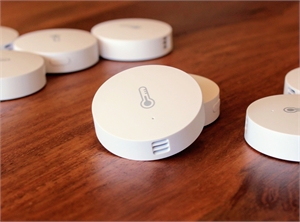
The heating receiver is reduced to no more than a wireless controlled a relay. As its mains powered, it can be connected to the hub by a WiFi connection, instead ZigBee. Most heating receivers have replaced the older thermostats, typically in the hallway. This is no longer necessary, because the wireless relay to control the boiler can instead be located in the vicinity of the boiler.
Just like having remote control for the TV, this is much more convenient than having to get out of your seat, walk across the room, and adjust a setting on the thermostat. New users also only have to become familiar with using the app, and not with the thermostat.
The room temperature still needs to be measured, but this only requires a small, coin sized temperature sensor, or even a motion sensor, which also measures the room temperature. This reduces the cost of the smart heating system, because a £130.00 thermostat is replaced with a £30.00 sensor.
Zone Heating
The smart thermostatic radiator valve (TRV) is the ultimate in zone heating, because they enable the temperature to be controlled independently in each room. Smart TRVs are still relatively new, and their cost, including installation, is probably still too high to justify their use.
An interim approach is have a temperature sensor in each room, so that any room can be selected to control the heating. For example, the kitchen or the bathroom might be selected in the early morning, the kitchen at lunch time, the living room during the evening, and later the bedroom.
Although the temperature in the other rooms will be higher or lower than required, at least the chosen room will be at the most comfortable temperature.
The room selection can be either manual, via the app, or scheduled to suit the normal pattern of behaviour through the day.
It does cost an additional £30.00 per room, for the temperature sensor, but the temperature can be measured with a motion sensor. The motion sensor can be used to detect the presence of people, and hence be used for other purposes as well.
Thermostatic Radiator Valves
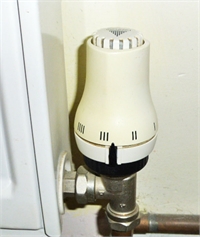
Thermostatic Radiator Valves (TRVs) have been in use for more than a decade. These were simple mechanical devices that replaced the normal hand valve fitted to each radiator.
The Danfoss TRV is one such example. Although their adjustment is relatively crude, and the temperature is measured adjacent to the radiator, these valves enable the temperature in each room to be adjusted to suit its occupants.
These valves, which are fitted to every radiator in the home, are used in conjunction with a thermostat such as the Sunvic unit shown above.
The operation of the boiler and the circulation pump for the central heating are still controlled by this single thermostat. For this reason, the temperature at the thermostat has to be set high enough to ensure an adequate flow of hot water to the radiators in the other rooms.
Fortunately, being wireless and hence portable, this particular thermostat can be moved round the home to provide the required level of comfort in the chosen room.
These simple TRVs do save energy, because the alternative is for thermostat, which is located in a particular room, to be adjusted manually to give the right temperature.
Without manually adjusting the radiator valves in every other room, the temperature in those rooms then increase and decrease with the changing thermostat temperature. The use of TRVs ensures that the temperature in these others do not exceed set values.
Smart TRVs
Smart TRVs provide all of the benefits of manual TRVs. In addition, they can be monitored and controlled centrally with an app, both through a local WiFi connection within the home, and remotely through an Internet connection.
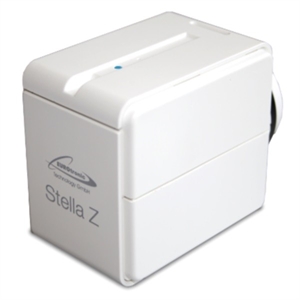
We found the Z-Wave EUROtronic STELLAZ TRV to be one of the best. It appears to have a longer battery life than most, and it both accepts a target temperature and reports the actual temperature.
Other TRVs only accept a target temperature, so the room temperature has to be measured with a separate temperature sensor.
Knowing the temperature of each room, either via the TRV, or separately, the control system only turns the heating boiler, and circulatory pump, on when at least one of the rooms is below the required temperature.
The fitting of a smart TRV requires a person with plumbing skills. The central heating system has to be drained of water, and the manual control valves have to be replaced. This has to be achieved without either damaging the pipework, or having any subsequent leaks.
The installation is much simpler for those with existing manual TRVs, because the smart TRVs are mechanically compatible. Only the control valve, as shown above, is replaced. This does not require a skilled plumber, or cause any interference with the central heating pipework.
HVAC
Our work on heating so far has been entirely UK based. HVAC in the home is yet to take off in the UK. We anticipate working with existing users in the USA to extend the capability of the new system to accommodate different types of heating, air conditioning, and humidity control.